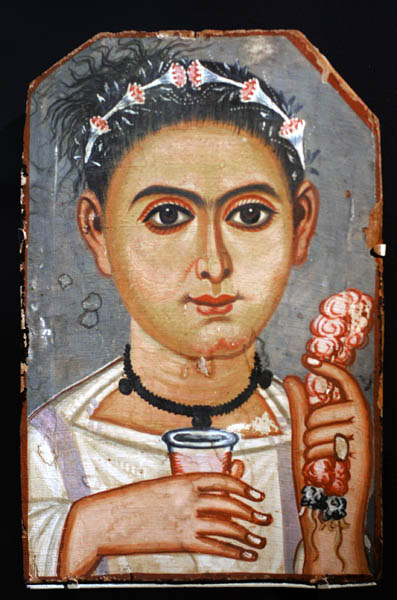 Cartonnage is the term used in Egyptology and Papyrology for plastered
layers of fibre or papyrus, flexible enough for moulding while wet against the irregular
surfaces of the body; the method was used in funerary workshops to produce cases,
masks or panels to cover all or part of the mummified and wrapped body. The plastered
surface gave an even ground for painting motifs with greater stability than was
possible with a linen shroud.
Cartonnage is the term used in Egyptology and Papyrology for plastered
layers of fibre or papyrus, flexible enough for moulding while wet against the irregular
surfaces of the body; the method was used in funerary workshops to produce cases,
masks or panels to cover all or part of the mummified and wrapped body. The plastered
surface gave an even ground for painting motifs with greater stability than was
possible with a linen shroud.
Sometimes cartonnage is compared with papier mache, but there is no pulping of the substrate, whether papyrus or linen: instead, smaller or larger sections of linen are cut to shape, and layered, and the plaster applied over the top. The method of preparation preserves the sections, and for this reason papyrus cartonnage is a prominent source of well-preserved manuscript sections.
There are four principal periods of use of cartonnage, each with distinct ingredients and effects:
In the early Middle Kingdom, mummy masks might be made from plastered linen; by the mid-Twelfth Dynasty workshops were producing longer masks covering the upper body, and there were eventually mummy-cases (in wood) enveloping the whole body. The first mummy masks appear at the end of the Old Kingdom (about 2686-2181 BC) . They are usually made in stuccoed linen (cartonnage). In the First Intermediate Period they are very common in elite burials. In the Middle Kingdom (about 2025-1700 BC) some examples are inscribed. In the New Kingdom (about 1550-1069 BC ), Third Intermediate Period and Late Period mummy masks appear in some elite burials, but became widespread again only in the Ptolemaic and Roman Periods.
In the Third Intermediate Period the innermost coffin of elite burials was replaced by a mummy-case made in cartonnage (linen and stucco). These mummy-cases, often also simply called 'cartonnage' were brightly painted. They are no longer in use by the Late Period.
In the Ptolemaic Period, from the reign of Ptolemy III, to the very beginning of the Roman Period, perhaps no later than the reign of Augustus, cartonnage elements and masks were produced from old papyrus scrolls; during this period, many masks and elements were also being produced with linen in place of papyrus
In the Roman Period mummy masks (see image to the right) and decorated pieces placed on the mummies were being produced from thicker fibrous material supporting a thicker layer of plaster. The image could be painted using Encaustic (melted wax) or Tempera (pigment mixed with egg yoke) on wood and some were gilded. These portraits were probably painted by itinerant artists living in the Faiyum. The panel, made up of cypress, lime or sycamore wood, was prepared with a ground of gypsum plaster or plaster of whiting and glue. The portrait was roughly sketched on this in black or red paint. The paint, made from natural mineral or vegetable pigments, wax then applied. As a medium for the paint, either water and an adhesive material were used or, more often, the pigment was ground and mixed with wax. Most portraits were originally square prior to being cut down in size to adapt to the face of the mummy. Flinders Petrie found the trimmed side and corner pieces beneath one portrait, tucked into the mummy wrappings, which led him to the conclusion that the portrait of the individual was sent to the embalmer after death to have the frame removed, and be trimmed down to fit the mummy's face. Sometimes a gold wreath painted across the hair, and a more elaborate form of jewellery would then be added to provide the deceased with greater richness of jewellery in the afterlife.